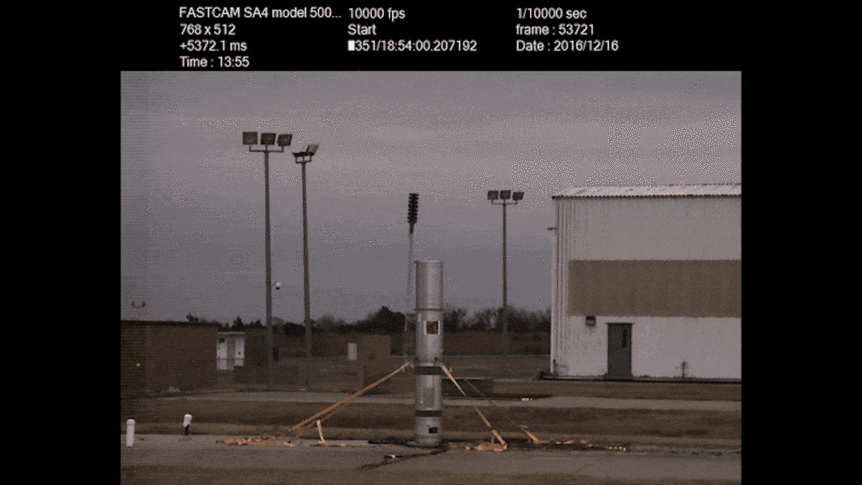Create a free profile to get unlimited access to exclusive videos, sweepstakes, and more!
NASA's Explosive Weather Machine Created a Cloud in the Upper Atmosphere
Forecasts predict 100% chance of being awesome.

Flint Lockwood (Bill Hader) is the well-meaning mad scientist in 2009’s Cloudy with a Chance of Meatballs (streaming now on Peacock). When the sardine-based economy of Flint’s home island is threatened, he invents a machine – the Flint Lockwood Diatonic Super Mutating Dynamic Food Replicator, FLDSMDFR for short – which transforms water into food. When the machine accidentally launches itself into the air, meatballs and all manner of other foods start to fall from the sky like fast food manna from heaven.
RELATED: The End of Clouds? How Climate Change Could Alter the Sky
While there aren’t any tasty flying snacks on offer, scientists are curious about a rare and poorly understood kind of cloud which forms high in the atmosphere over the north and south poles only during the late spring and summer months. Understanding how these clouds form, how they evolve, and the impact they might have on the wider ecosystem is increasingly important as we continue to manipulate our ecosystem. And the best way for scientists to figure that out was to create one of these rare clouds themselves.
NASA’s Super Soaker Cloud Making Mission
The clouds in question are known as polar mesospheric clouds (PMCs). They exist at altitudes between 82 and 85 kilometers (51 and 53 miles) up, are small, wispy, and difficult to see. Astronauts orbiting aboard the International Space Station get a unique view to these high-flying clouds but observers on the ground can best see them during twilight. When the sky is dark, but the Sun still illuminates the fringes of the atmosphere, these polar clouds can become lit in stunning detail.
PMCs form naturally only during certain parts of the year when temperature and humidity are in the right range to form high-altitude ice crystals. Scientists have also seen them forming in the wake of rocket launches as water vapor – a byproduct of spent rocket fuel – gets dumped into the upper atmosphere. As humanity’s space-based activities continue to ramp up, understanding the origin and impact of PMCs could be increasingly important.
RELATED: Revisiting the Weird and Wonderful Cloudy With a Chance of Meatballs
“What has attracted a lot of interest in these clouds is their sensitivity – they’re occurring just on the edge of viability in the upper atmosphere, where it’s incredibly dry and incredibly cold. They’re a very sensitive indicator of changes in the upper atmosphere – changes in temperature and/or changes in water vapor," said Richard Collins, lead author of the paper, in a statement.
The experiment, published in the Journal of Geophysical Research, was a product of NASA’s fantastically named Super Soaker mission, which launched from NASA’s Poker Flat research range in Fairbanks, Alaska on the morning of January 26, 2018. Once it reached an altitude of 85 kilometers, scientists detonated an explosive canister holding 220 kilograms (485 pounds) of pure water.
Using LiDAR measurements from the ground, researchers confirmed the production of a PMC within 18 seconds of detonation. The cloud peaked at about 92 kilometers up and descended to an altitude of 78 kilometers over the next three minutes. Along the way it facilitated a rapid temperature drop of the surrounding atmosphere, on the order of 25 degrees Celsius (45 Fahrenheit).
Today, water in the mesosphere exists within a balanced cycle. Water vapor forms into ice crystals forming PMCs which more readily absorb heat, causing them to sublimate back into vapor. Then the vapor cools and forms clouds again when the conditions are right. The clouds lower the temperature, then absorb heat and bring it back up, then form into clouds again and the cycle continues. If, however, we started to launch a lot more often and increased the water vapor budget in the mesosphere, it’s not totally clear what might happen. Which means we might need to toss a few more water balloons at the sky to figure it out. As long as no one gets buried in a giant cheeseburger falling at terminal velocity, everything should be alright.
Catch Cloudy with a Chance of Meatballs streaming now on Peacock.
















